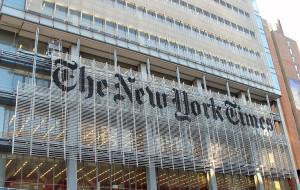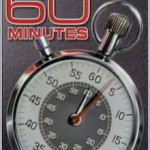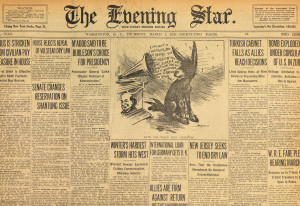Journalism Isn’t Dying, but It Will Never Be The Same Again – It Will Be Better
First In a Series: The State of Journalism Today
I’ve had a lover’s quarrel with journalism most of my adult life.
 As in any lover’s quarrel, I get pretty heated when journalism lets me down. But only because the love burns deep within me.
As in any lover’s quarrel, I get pretty heated when journalism lets me down. But only because the love burns deep within me.
I so want journalism to thrive; to prosper; to fulfill its stated mission, and to deliver the value it promises. But too often, and seemingly with increasing frequency, journalism fails to live up to its stated ideals.
I’ve made a pretty good living helping people navigate the vagaries of journalism – protecting them from its excesses, helping them capture the best of journalism to mutual advantage when they can. In the process I’ve gotten to know a lot of journalists and to care deeply about their craft. And to lament the deteriorating state of the business.
Today I begin a multi-part look at the state of journalism, its role in our democracy, and the challenges it faces.
My first post is about the future.
The Conventional Wisdom is Wrong
The conventional wisdom is that journalism is dying.
I think the conventional wisdom is wrong.
Journalism isn’t dying, but it is in the throes of a revolution that will transform it — for the better.
Fasten Your Seatbelts – It’s Going to Be a Bumpy Ride
While we daily witness the decline and fall of newspapers and the trivialization of television news, there’s nevertheless reason for hope.
Although at the tactical level in the short term the prognosis for journalism is grim, at the strategic level the long-term outlook is quite promising. But it will be a bumpy ride.
I believe that journalism is undergoing a paradigm shift – as the term was originally coined in 1962 by the philosopher of science Thomas Kuhn.
 Kuhn’s The Structure of Scientific Revolutions is one of the most influential books of the last century. In it Kuhn describes a paradigm shift as more than just a different perspective. Rather, a paradigm shift is fundamentally disruptive, changing an entire worldview.
Kuhn’s The Structure of Scientific Revolutions is one of the most influential books of the last century. In it Kuhn describes a paradigm shift as more than just a different perspective. Rather, a paradigm shift is fundamentally disruptive, changing an entire worldview.
A paradigm shift doesn’t just revise a theory; it completely redefines the basis on which a theory is held, and changes the meaning of the enterprise altogether. Think flat-earth/round earth; sun revolves around the earth/earth revolves around the sun; disease as imbalance of bodily humours/germ theory of disease; etc.
And Kuhn notes that the old guard tends to resist, kicking and screaming. But a vanguard moves forward to change the paradigm, what Kuhn calls “revolutionary science.” Kuhn quotes the physicist Max Planck, who noted that a new paradigm is embraced not just because some people see the light, but also because the old guard simply dies off.
I believe journalism is undergoing just such a revolution.
Re-Inventing Journalism
Journalism as we know it is essentially a 19th Century industry that has been only incrementally updated. But the journalism my teen-age daughters will know as adults will be fundamentally different from the journalism most of us grew up with.
The paradigm shift is playing out in three dimensions:
- How we and journalists understand the idea of time.
- How we and journalists understand the nature of the medium (e.g., print, broadcast, wire service, etc.).
- The direction in which journalism is conveyed.
Each of these is disruptive in its own way. And redemptive as well.
Adventures in Time
 The basic dynamic of journalism is that it’s a timed phenomenon. The very word “journalism” is rooted in the French for “day.” We have a daily newspaper; a nightly news program; a weekly magazine. Even in an all-news environment, it’s 24-hour news.
The basic dynamic of journalism is that it’s a timed phenomenon. The very word “journalism” is rooted in the French for “day.” We have a daily newspaper; a nightly news program; a weekly magazine. Even in an all-news environment, it’s 24-hour news.
Journalism has traditionally been pegged to a specific time and place. Each morning a printed paper arrived (often thrown by teenager on a bike – one of my early jobs). On television there was an evening newscast. The cycle of journalism matched the cycle of our day.
And a journalist’s life was pegged to that news cycle. Deadlines abounded, all driven by the need to get the presses rolling at a particular time in order to feed all the delivery folks by dawn. Or to get a group of stories on the air just around dinnertime. The deadline drove the product: a story was printed not when it was done but when it was time to print.
But in the rush to be immediate, journalism is also fleeting. It is a perishable commodity. And after the story was read, the paper on which it was printed was thrown out, or used to wrap dead fish, line birdcages, or housetrain puppies.
 The deadline pressure also contributed to the desire to be first – to get the scoop. So you saw (mostly in the movies) the paper’s owner scream to “stop the presses” to get a breaking story in the paper at the last minute. Or “Extra” editions hawked by schoolkids on street corners (again, mostly in the movies).
The deadline pressure also contributed to the desire to be first – to get the scoop. So you saw (mostly in the movies) the paper’s owner scream to “stop the presses” to get a breaking story in the paper at the last minute. Or “Extra” editions hawked by schoolkids on street corners (again, mostly in the movies).
But the desire to be first often crowded out the impulse to get it right the first time.
Sometimes the urge to be first created peculiar rituals. Early in my career – in the days before faxes, e-mail or the Internet – the norm was to have two people simultaneously read the same announcement to Dow Jones New Service and Reuters News Service, so that neither would have an advantage over the other. If the same person called one and then the other, there’d be hell to pay from the second service for allowing the competition to beat it by a minute or two.
The specificity of time – and the fleeting nature of the news product itself – meant that there was a constant need to feed the beast, but very little permanence.
 The paradigm shift here is disruptive. Journalism is now splitting into two different forms, defined by time: 1) The headline-only here-and-now mode, such as what you see in some office building elevators or in the back seats of New York City taxis – just a few words to give a snapshot of the world at this moment; and 2) more serious looks at things that matter beyond this moment.
The paradigm shift here is disruptive. Journalism is now splitting into two different forms, defined by time: 1) The headline-only here-and-now mode, such as what you see in some office building elevators or in the back seats of New York City taxis – just a few words to give a snapshot of the world at this moment; and 2) more serious looks at things that matter beyond this moment.
But the shift is also redemptive. Once freed of the need to produce news at a particular moment, or to be first to market, journalists will be able to spend more time on their subjects, vet their stories better, get more perspectives, and ultimately put out a higher-quality product. And since everything is now archived, sortable, and searchable much of this journalism will have a shelf-life well beyond the here and now.
The paradox is that as news becomes an all-the-time, any-time phenomenon, it will become timeless.
The Medium is the Messenger
The remaining vestige of journalism as a 19th-Century industry is the paper on which it’s printed.
 The written form – “print journalism” – carries this anachronism in its name even as the form migrates from tree-based media to electron-based media.
The written form – “print journalism” – carries this anachronism in its name even as the form migrates from tree-based media to electron-based media.
The basic delivery system of the written word is changing. I now read my New York Times, Wall Street Journal, and some magazines and books on Amazon’s Kindle machine. For a decade newspapers have created ever-more robust web presences. But the tipping point hasn’t yet been reached.
Here’s my prediction. The relationship of the printed page to the electronic format will shift fundamentally.
Whereas up to now the paper version is the primary product, and the electronic version is the brand extension, my daughters’ generation will see this reversed. The core news product will be electronic. The paper version will be essentially a pointing device that previews the offerings that can be found online. The newspaper will essentially become like what TV Guide once was: A menu of what’s available elsewhere.
And, as Max Planck predicted, some old school consumers of journalism will insist on getting the print version as their primary read. But then they’ll be converted or die off, and eventually the print version will disappear.
But this too is both disruptive and redemptive. If the medium is only a messenger, then the quality of journalism will improve as well.
Journalism online will feature the written word, but also pictures, moving pictures, sound, and all of these combined. It will have the best of television, radio, print, and more. This is not just a content/channels play that big media companies have glommed onto, where a single story is sliced and diced into multiple forms.
Rather, this will transform journalism to be medium-agnostic. Stories will be told (or shown, or presented, or shared – we don’t even have the right vocabulary to describe this yet) in any number of ways, given the needs of the audience or the dynamics of any particular story.
And any given story will be initiated by the reporter in a medium-agnostic way. The distinction between daily or weekly journalism; between print and broadcast; between front page and inside-the-paper, will become meaningless. There will simply be news.
Sense of Direction
For centuries journalism was a one-directional affair.
An authority figure told you “that’s the way it is” or that you had received “all the news that’s fit to print.”
These days journalism is becoming multi-directional.
As my colleague Laurel Hart has noted here, journalism is moving from something consumed by passive readers to “networked journalism” where the initial story is just the starting point for a rich discussion where citizen journalists work with professionals to create a much more nuanced and textured story.
Today subjects of news stories can post replies on Google; post objections directly on the websites of the news organizations who quoted them. More significantly, readers can call attention to errors, provide additional perspectives, and provide links and documents that make the story richer and more meaningful.
So while the decline of the authority figure will be disruptive, the result will be redemptive: the quality of the journalism will improve. But so will the relationship between journalism and its readers (again, we don’t have the right vocabulary yet). Readers will become sources and experts, and be in ongoing relationship with the reporter and with any given story. In other words, readers will have a direct stake in the product.
Out of the Ashes…
So I’m optimistic about journalism and its role in our society.
As with any revolution, there will be huge disruptions, job loss, consolidation, and outright rejection of traditional ways of doing things. And journalism will need to figure out how to get paid for its work.
But from the turmoil will emerge a better form of journalism, unfettered by the vestiges of being just a 19th Century industry with a work-around adaptation to technology.
In future posts: The state of journalism today; pioneers in the renewal of journalism, and, hopefully, some of your views as well.
Your comments and insights are welcome…
Fred







Leave a Reply
Want to join the discussion?Feel free to contribute!